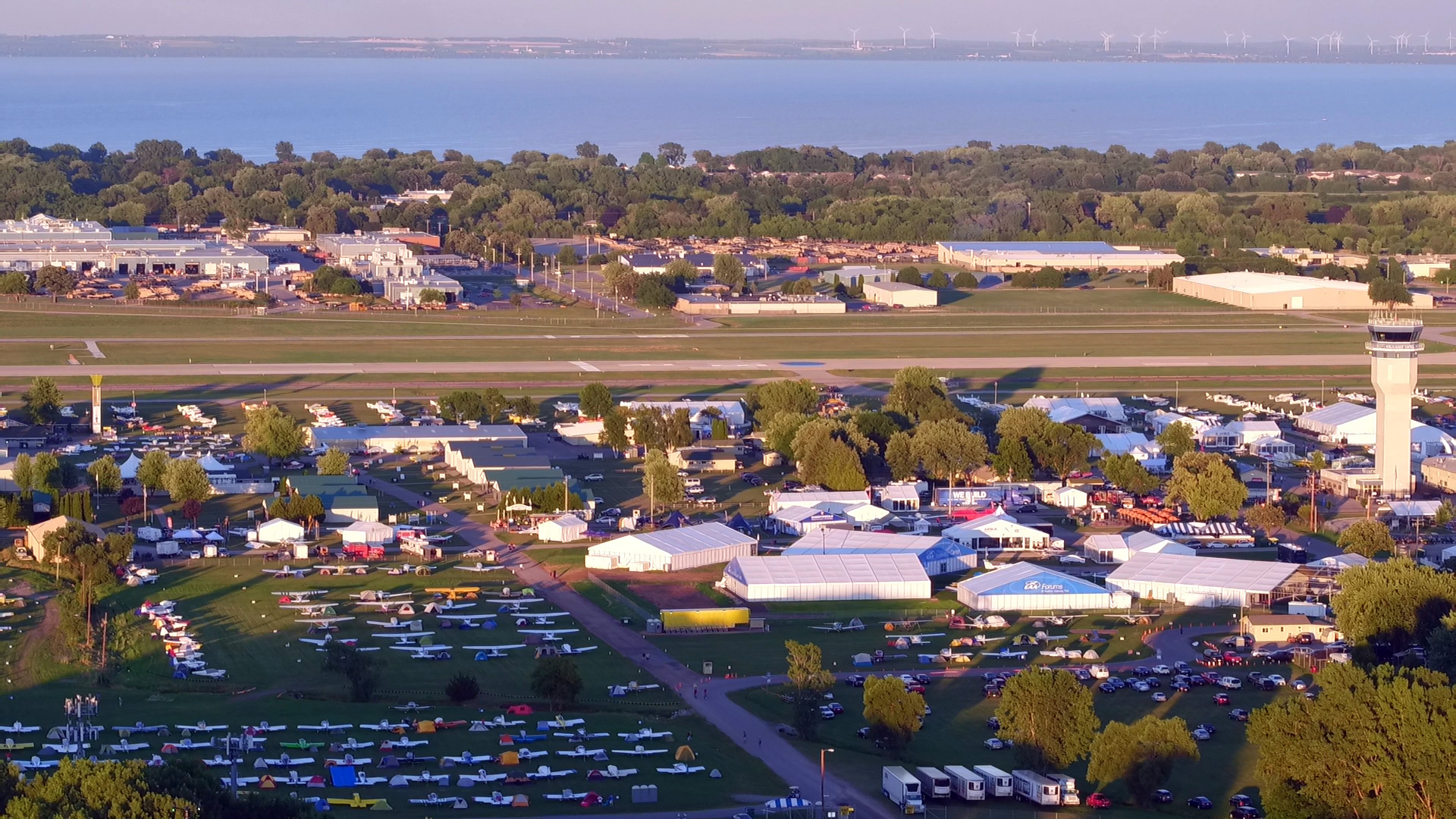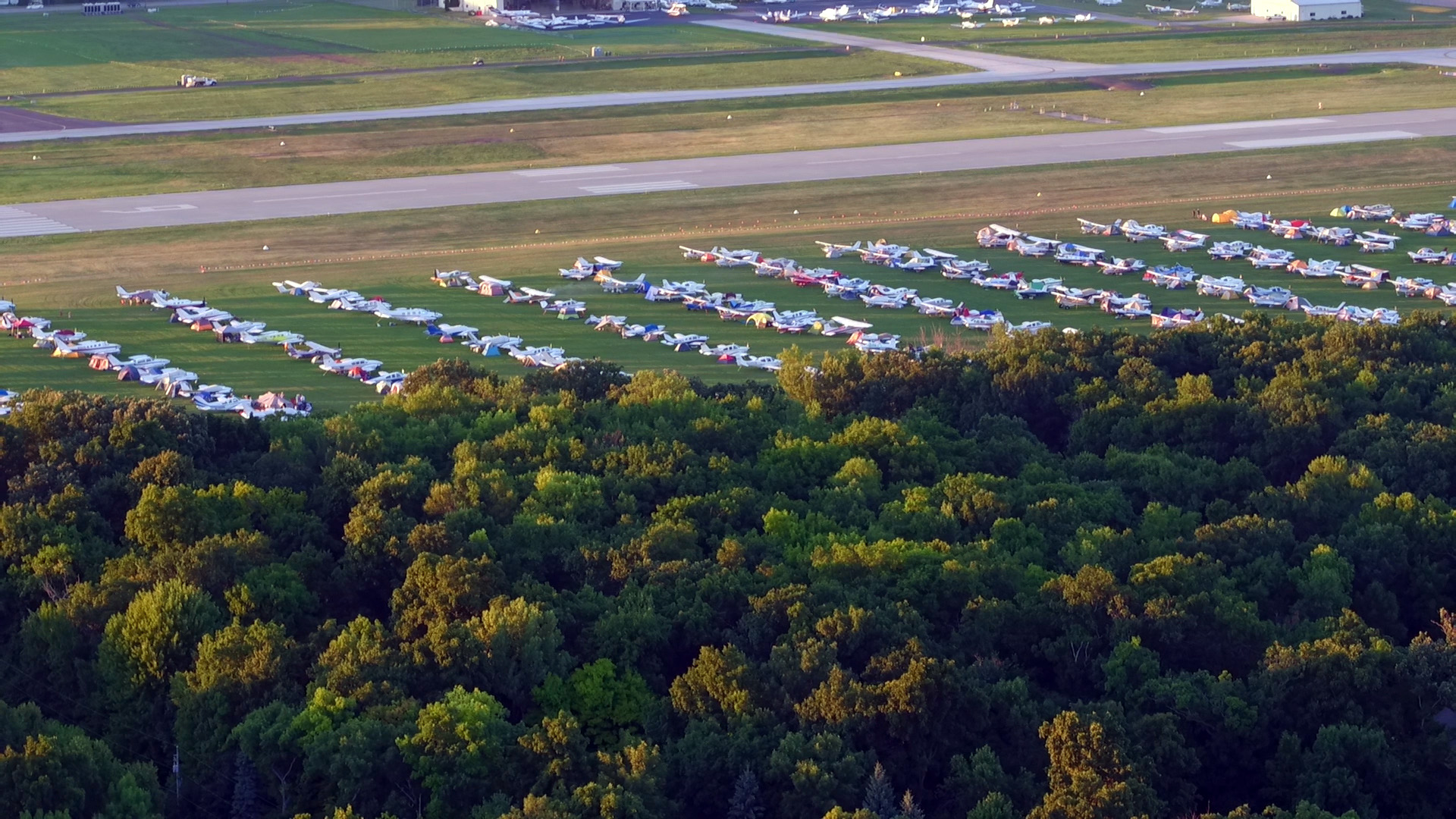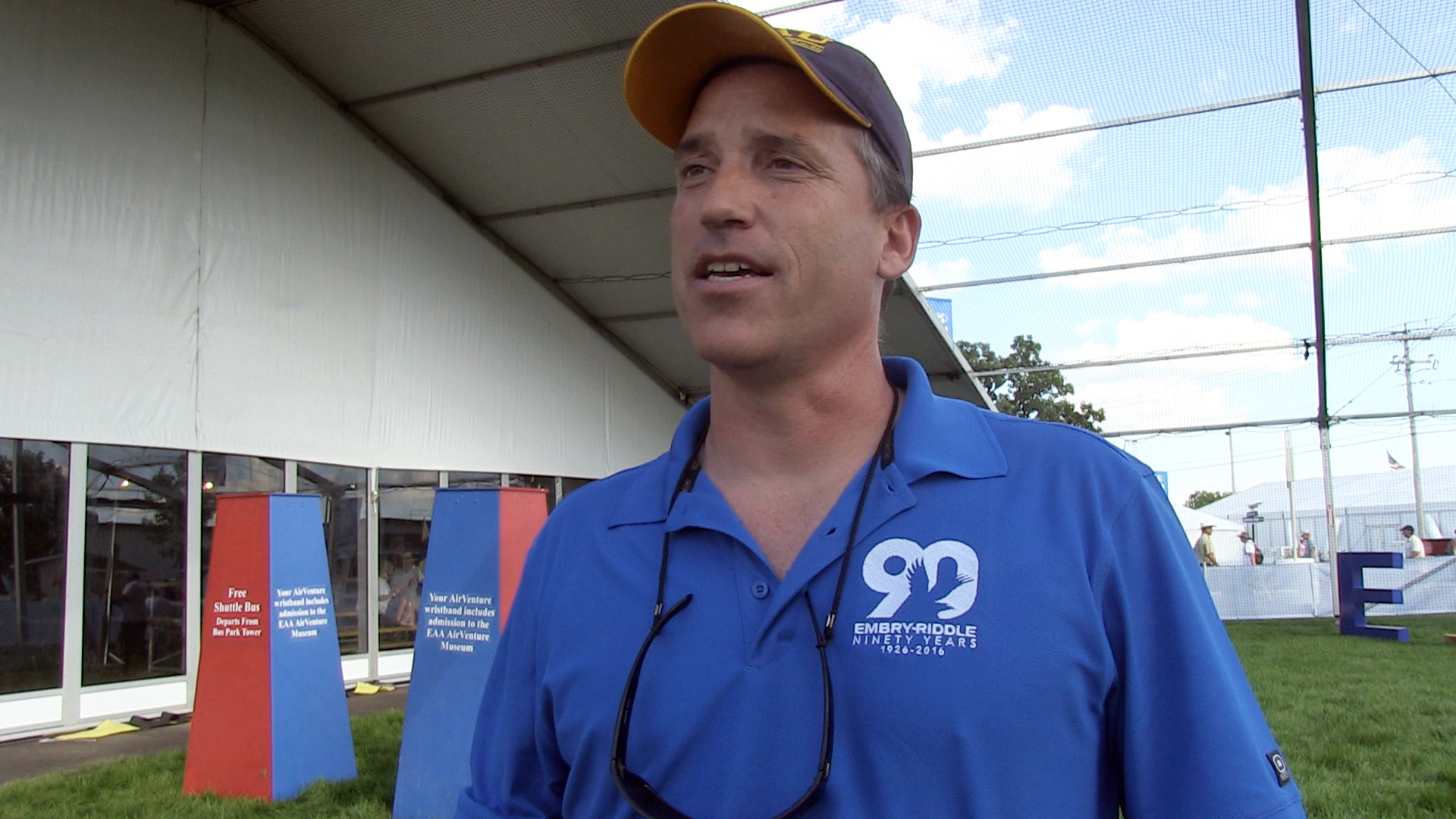Inspired integration
EAA draws drones to AirVenture
Pioneer Airport’s grass strip, just in front of the EAA AirVenture Museum, was the designated area where RC models and drones (the newest generation of multirotor systems that are able to self-stabilize, and more easily controlled than traditional model aircraft) shared the sky without causing any showers of plastic parts. Which seems mildly amazing, given the density of traffic during the evening sessions.
Flying a DJI Inspire borrowed from Multicopter Warehouse Chief Operating Officer Kerry Garrison (a rig that costs more than $4,000 with accessories), the pucker factor increased as I lifted off, then climbed the flying camera with all deliberate speed straight up to 350 feet. That put my borrowed camera overhead and somewhat above the fray while leaving a 50-foot cushion below the 400-foot mandatory ceiling. (The event organizers were invited to fly on the airport grounds, so notification was taken care of, but the other rules and requirements that apply to hobby use of unmanned aircraft, detailed by the Know Before You Fly online campaign, were fully in force.)
Fixed-wing models and racing quads darted to and fro, all powered by batteries. Mark Radcliff, a district vice president with the Academy of Model Aeronautics who ran the nightly sessions, had pointed out a traffic pattern during his pilot safety briefing, though that pattern was rather loosely interpreted by some. Still, there were no serious incidents. I watched one midair involving another Inspire, and cringed as a small, fixed-wing model struck its camera, but it was a glancing blow. Both the camera drone and the fixed-wing foam airplane flew on, apparently unscathed. All aircraft stayed faithfully within the horizontal boundaries of the turf runway marked by cones, keeping well away from any active runways then in use by the thousands of larger aircraft that arrived and departed during the week.

Radcliff, reached by phone for a follow-up interview Aug. 2, said the week of organized RC model and drone flying run by AMA (at the request of the Experimental Aircraft Association) was a great success, with 116 pilots having registered for the evening sessions by the end of the week. Many of those pilots flew more than one night, and the crowds grew larger than expected. Pilot registrations were up from 78 drone pilots and RC modelers in 2015, the first year of organized, unmanned, outdoor aviation at AirVenture.
The evening sessions were organized and pilots obeyed the rules. Radcliff said he only had to have one or two conversations with operators to point them in the direction of the sign-in tent. (AMA membership was required for all participating pilots, though arrangements could be made to join, and learn the AMA safety code and operating rules on site.)
Sanctioned drone flying was motivated in part by necessity, Radcliff said. In 2014, there were at least a few drones and model aircraft flown over camping areas and other parts of the sprawling AirVenture campus and campgrounds.
“EAA had the right idea” bringing them into a designated area, said Radcliff, who is also a general aviation pilot and AOPA member.
‘They all followed me over’
The drone boom, which has seen a million or more quadcopters sold in the past few years, has made headlines and inspired angst, particularly among GA and airline pilots alarmed by reports of drone sightings, including several in runway approach or departure zones, or other highly inappropriate places.
But education, both of manned and unmanned pilots, is making a big difference, Garrison said. Manufacturers have tightened the electronic leashes, hobbyists are educating themselves through the Know Before You Fly campaign backed by AOPA, EAA, and AMA, among other organizations, government agencies, manufacturers, and companies like AirMap, which provides tools for drone pilots and manufacturers that help keep drones out of dangerous places. Manufacturers have expanded the literature that is shipped with the new drones still flying off of store shelves. Attitudes are shifting.
“I’m still floored every time I think about how the general attitudes have changed in a year,” Garrison said. In 2015, the first year EAA officially welcomed drones to AirVenture, Garrison got an earful from concerned pilots, and some of those comments were downright nasty, he said.
“This year it was ridiculous the amount of product that we sold, and the response to all the different talks that all of us gave,” Garrison said. This year's customers included many pilots of manned aircraft, longtime members of a GA community that had previously given a chilly, even hostile reception to the newcomers thought to be filling the skies with quadcopters that practically fly themselves.

Garrison delivered an opening day forum presentation on the new rules for commercial drones weighing less than 55 pounds that will take effect this month, and drew an audience of 95 with another 91 watching online. Garrison pointed out that in addition to the location limits imposed by the geo-fencing built into DJI products (and other brands) to keep them away from airports and other sensitive areas, no DJI drone can fly higher than 1,650 feet above the launch point. (DJI is the undisputed market leader in the camera drone world, with up to three-quarters of the total market by some estimates.) That, Garrison said, is a hard limit that operators cannot override.
While DJI aircraft specifications list a service ceiling of around 12,000 feet, Garrison said reports of drones spotted by pilots at 3,000 feet or more over flat terrain have to be either mistaken identification, or homemade products that do not have the built-in safety features that major manufacturers of small drones have embraced. (I have personally experienced the “soft” altitude limit built into DJI systems: A warning message alerts the pilot when the drone reaches 400 feet above the launch point, and allows the pilot to override this limit. This is useful in locations where terrain elevation changes make it safe and necessary to fly higher than 400 feet above the launch point.)
Garrison, who is not a manned aircraft pilot, said that as he addresses GA groups and explains these safety features to pilots, along with the capabilities of systems that can navigate with exquisite precision carrying sophisticated cameras and other sensors, open hostility is usually replaced with keen interest.
“People fear what they don’t understand,” Garrison said. “This year there was a much greater understanding. We need to work together. We all need to be on the same page. That's what we're here for."
His company had to order two additional rush shipments of the DJI Phantom 4 to AirVenture, having nearly sold out of the $1,400 model with a 4K camera and technology that helps steer them around obstacles. Such was the demand over the course of the week, and it came as a pleasant surprise to the vendors and manufacturer representatives on site. Garrison said many of those customers were pilots, including those under age 50 who were typically interested in turning a profit with their rigs, as well as older pilots whose flying days are nearing an end, who found in the drones a way to extend their aviation lives, watching the view from up there provided by an ultra-high-definition, stabilized video camera that beams images in real time. “That was kind of cool,” Garrison said.
On July 30, he gave an introductory presentation to a group of about 75 campers on the far side of the airfield, many of whom were unaware that AirVenture even had an official drone pavilion, and “they all followed me over there” after the talk, Garrison said.

Back at Pioneer Airport, where safe integration of unmanned aircraft was being worked out at the grassroots level directly over a grass runway, another drone pilot who is deeply involved in the effort to safely integrate the newcomers took time out from flying his own DJI Inspire, and showing spectators what it can do, to talk. Archie Stafford is a government contractor with thousands of hours flying a wide variety of drones, including those made for military use, and he also serves as the AMA UAS4STEM program’s national director. Stafford said the drone boom has created both challenges and opportunities for the wider aviation community.
“There’s a brand-new crowd out there that people need to reach out to, to try to educate and bring into the fold,” Stafford said.
AMA, which joined AOPA supporting the Know Before You Fly campaign, also has created online interactive learning tools for students and teachers as part of that effort. The organization also welcomes newcomers with freshly purchased drones in hand to AMA airfields around the country.
Stafford and Radcliff both said that while there was some resistance, at first, from members of the RC model community, that, too, is easing. RC model enthusiasts have been flying safely for decades with organization and rules, not to mention aircraft that require considerably more skill to fly than a DJI drone. Some were distrustful of the new drone crowd. Both men agreed that while not every mind has changed, attitudes are shifting as education and cooperation replace mistrust and fear.
“Our jobs are to teach the safety,” Radcliff said. “That’s why it’s important that we get them to our flying fields.”
Stafford said hands-on education for commercial operators will also be an important part of safe integration, and he has also joined that effort personally through Fly Robotics, a company dedicated to commercial operations and training.
Back at the AirVenture Drone Center, another educator was also putting drones in people’s hands. David Thirtyacre, assistant professor at Embry-Riddle Aeronautical University and chairman of the university’s unmanned flight operations, said drones have become an important part of the curriculum at the collegiate level (Embry-Riddle students can fly drones of various sizes, ranging from small quadcopters with which they learn the basics up to much larger, military-grade systems) as well as high schools and middle schools. The current generation of tech-savvy kids with notoriously short attention spans can get a lot out of a drone, Thirtyacre noted, because there’s much more to do than just fly them, and always a new task to turn to.
Drones have been designed specifically for educational use that must be built from kits, and maintained between flights. There is software to program, control systems to calibrate, and a host of mission-related tasks including photography, mapping, inspection, and other specialized skills that come into play, he noted.

A few steps away, Drones for Humanity, a crowdfunded startup company from Canada that aims to use drones for humanitarian and disaster relief missions around the world, displayed an octocopter built to carry a 50-pound payload. It has, to date, been operated exclusively line of sight, though the company plans to eventually use Automatic Dependent Surveillance-Broadcast technology to facilitate safe operation beyond line of sight. The FAA, NASA, and a consortium of academic and industry groups are also working toward the same goal. Some of the first products along those lines are already on the market.
There was also fun to be had. Each afternoon, Thirtyacre picked up a microphone and became a race announcer as parents gathered in grandstands to watch children (and at least a few adults) take turns racing small, hobby-grade quadcopters provided by Horizon Hobby through an obstacle course in a netted enclosure. Trophies were awarded, arms raised in triumph, while other heads drooped at drone "disasters" (such as getting stuck in the net) on the outside of the drone pavilion in Aviation Gateway Park.
Thirtyacre agreed that drones may prove to be a potent tool for growing the ranks of all pilots, and other aviation professionals, in the decades to come, offering a low-cost and fun way to get hands on flight controls, and get up in the air.
The “fun” quotient is not to be underestimated. It can be noted here that Thirtyacre, a fellow Embry-Riddle staffer, and an AOPA writer all took turns through the obstacle course after the day’s racing ended July 25. No sense leaving charged batteries on the shelf, after all.




